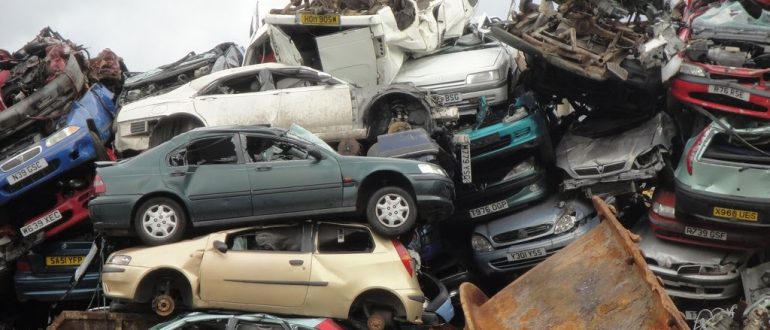You might be surprised to learn that your scrapped car is not lifted into a compacter that eventually turns it into a metal cube. In reality, recycling a scrapped car is a very painstaking process. Today more than 80% of vehicles are recycled and reused, and to achieve this figure car recyclers use a multi-step process to repurpose renewable materials from vehicles and other modes of transportation. In fact, car recycling is a major source of recycled scrap metal in Sydney where manufacturing companies can be locally provided with a cheaper metal. So how exactly are scrapped metals recycled?
Depollution
Car recycling starts with workshop engineers removing the engine and car fluids to ensure proper disposal. Car fluids include oil, gasoline, brake fluid, coolant, and windscreen wash, and more. Draining the car fluids makes vehicles safer to be recycled as it reduces the chances of fires developing in the salvage lot. Also, not only does depollution make the vehicle recycling process environmentally friendly, but also provides valuable material for resale, such as batteries – given their usefulness to other road users.
Recycling facilities keep the gasoline to use in their yard vehicles. Used oil is either sold to recyclers who process it into new oil or it is sold to industries that burn it in their furnaces. Other fluids such as antifreeze, transmission oil, or washer fluids are reused by the recycling facility.
By ensuring that car fluids are drained before other processes occur, a recycling plant can be confident that the vehicle can be disposed of in a controlled manner. After removing the fluids, the systems they have come through are flushed to ensure that no chemicals or impurities go unchecked.
Dismantling
With the car cleared of any harmful fluids or hazardous materials, the next step is to dismantle and strip down the car to its shell, in search of reusable parts. Copper Scrap can be found in cars in Sydney. The parts that are functioning or otherwise deemed to be valuable are saved for resale, while irreparable or dead parts are set aside for recycling. From the axles and seats to the car engines and even the stereo systems can all be recycled.
The catalytic converters, which filter cars exhaust emissions, contain metals such as platinum, rhodium, copper and palladium. Copper Scrap in Sydney might be sourced from some of these car parts. These metals are extracted before their ceramic inner is opened. Opening this inner part is hazardous, so catalytic converters are removed from the vehicles to be dismantled individually.
Often, recycling companies send automobiles to junkyards first which saves them time and energy. Junkyards remove certain parts that recycling facilities for copper scrap metal in Sydney may not be interested in, such as tires, rubber hoses, plastic reservoirs, batteries, and synthetic fibers to name a few. These items are set aside and recycled separately.
Crushing and shredding
After the dismantling of the vehicle and removal of reusable parts is done, the metals in the vehicle are crushed. The car is compacted for the ease of transport during recycling; this process helps the vehicle take up less space before it is sent to a car shredder. The metal recycling facility then puts the crushed car metal in a shredder that separates metal fragments into non-ferrous and ferrous metal, magnetically. Hence, the shredding process transforms the leftover crushed car into small bit-sized pieces separated from the impurities as well as plastic.
After separation, the metal is treated with a chemical solution to remove the thin layer of tin that prevents the steel from rusting; the process is called “detinning”. The vehicle, now turned to scrap steel and aluminum, can be aptly sold as scrap metal. However, before this shredded scrap metal can be sent to manufacturers, recycling facilities melt and combine metals to strengthen them and to make the metal stronger. The resulting metal is now prepared to be molded into new automobile frames.
Other shredded materials that include a mixture of fibers, plastics, rubbers, and glass can be difficult to handle. They are recycled in several ways including using them in industrial chemical processes, converting them into synthetic crude oil, or using them for other manufacturing processes.
Sending to manufacturers
The final step in recycling scrap cars is to send the resulting recovered products to manufacturers. Junk cars provide steel and iron which are commonly used for producing new items. They can even provide a small quantity of Copper Scrap metal in Sydney. It is much cheaper for the local manufacturing plants to use than mining and extracting the virgin metal. Aluminum and steel from scrap cars are one of the major sources of metals for the manufacturing and transportation industry.
Other products like tires are transformed into products such as roofing or playground surfaces. Plastic from the dashboard or interior trims is turned into a polymer and can be used in a variety of commercial and industrial items. On the other hand, glass can be reused for an indefinite amount of time. Grinding the glass essentially turns it into the sand and from there it can be reused and heated to form glass once again. Seats and upholstery fabrics are likely to become household furnishings such as chairs, sofas, and mattresses.
Takeaway
Scrapped cars provide valuable resource materials for various industries, mainly the metal-making industry, after careful examination and processing. Components in good working condition or panels in a good shape are cataloged for future sale while others are sent for recycling. In the end, items from scrapped cars live on in a new form providing not only environmental but economical advantages as well.
Disclaimer: This is a generic Information & post; content about the services can be changed from time to time as per your requirements and contract. To get the latest and updated information, contact us today or visit our website.




